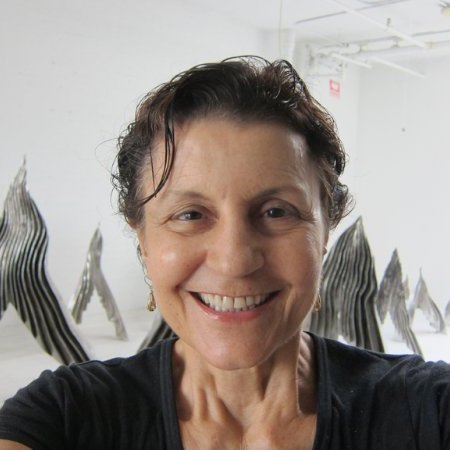Rosemary Castoro
Photograph Source
From Artist’s Website
Born in Brooklyn, Rosemarie Castoro (1939-2015) lived and worked in New York her entire life, becoming a central figure in the city’s Minimalist and Conceptualist Art scene.
Finding early inspiration in experimental dance and choreography while a student at the Pratt Institute, Brooklyn, and in subsequent collaborations with Minimal dancer Yvonne Rainer in the 1960s, Castoro’s work throughout her life exhibited a distinctly performative character and understanding of space and movement. From 1964 onwards, Castoro created systematic works exploring colour and structural compositions in highly innovative experimentations, like her Y-Unit, Interference and ‘Inventory’ paintings and drawings. In 1968 – a time of political unrest in the USA – Castoro abandoned colour and started to engage with Concept Art, Street Works, Concrete Poetry and Post-Minimal sculpture. From the 1970s until the last years of her life, Castoro focused on sculptural experimentation. She introduced surreal and sexual allusions into the rational and mathematical frame of Minimalism, her work’s organic shapes presenting a parallel to the experimentation of Eva Hesse and Louise Bourgeois.
Throughout her life she showed a tendency to blend media – declaring herself a ‘paintersculptor’. Neither wholly Minimalist nor feminist, her work transgressed and metamorphosed into an erotically charged language. The feminist critic and curator Lucy R. Lippard later identified her as a figure who ‘subverted or overrode Minimalism on its own turf’.
Her earliest mature works from 1964–65 were paintings executed on square format canvases first in painterly tessellated ‘Y’ shapes and later as geometrically rendered ‘Y’s against a monochrome ground, the minimal composition having the potential for infinite repetition (the first manifestation of a theme of infinity in Castoro’s work). The paintings are characterised by bold ‘literal’ colour in diverse, opposing or close colour contrasts, her colourism attracting the praise of painter Frank Stella. Castoro developed a friendship with the painter Agnes Martin, whose influence might be detected in these early minimal paintings through their precise execution and visible pencil drawing.
As Castoro’s painting developed, she fractured the ‘Y’ shapes into bars, distributing them as an all-over pattern: either in seemingly chaotic, chance compositions; in discrete though overlapping groupings; or else graphically regimented. While the ‘Y’ figure might be seen as standing in for the body, the anthropomorphic analogy can be continued in considering the bars as either bodies or demarcations of feet. The relation of painting to dance is revealed through a consideration of bodies within space and their graphic rendition in minimal dance notation.
From 1966, Castoro’s painting began to emphasise the seemingly random and irregular geometric forms created from the superimpositions or ‘interferences’ of one ‘bar’ over another. These works explore subtle and intermediate colour tonalities and close contrasts that, with their formal organisation, heighten the optical qualities of the works. Such work was included in the 1966 group exhibition Distillation curated by E. C. Goossen at the Stable and Tibor de Nagy Galleries, New York, one of two exhibitions curated by Goossen that helped to define Minimalism as a movement.
Two series of paintings of the later 1960s indicate Castoro’s increasing use of systems and her move towards Conceptual art. Near-monochrome abstractions, the Inventory paintings emulate her drawing practice by employing diagonal lines to record the measurements of space or an encounter with an artist friend, as in Portrait of Sol Lewitt with Donor and Friends – Oct 3, 1968. Another complementary series are her prismacolor works executed in pen through which Castoro built up surfaces of densely repeated lines. The importance of line, implicit in the visible under-drawing of her earlier works, comes to the fore in these paintings.
For a little more than two years, Castoro departed from painting and produced conceptual art in a diverse range of other media, including performance art actions enacted in both street and studio, concrete poetry and installation art. These works reveal the intersection of a concern with time and space in her work. This period also saw her involvement in activism through the Art Workers’ Coalition, which met in her studio at 151 Spring Street. Despite this political engagement, Castoro rejected becoming closely involved in feminism, which she saw as restrictive and a form of ‘segregation’. She also created a series of ‘stopwatch’ works recording her everyday routines and the duration of each task, exhibiting an obsessive attention to time.
In 1970, Castoro developed freestanding panels that occupied the space of the spectator. The surfaces were created from gesso applied with a broom and then covered in graphite hatching so that the works combine painting, sculpture and drawing. Castoro’s statement ‘my panels are my containers’ makes clear their relation to the body. These works are further reinforced as settings for the body by the numerous photographs she took and pasted into her journals, which show Castoro adopting dance-like poses within them or performing with ropes suspended in front of them. Castoro wrote in one of her journals: ‘I am in dirt continually… My studio is covered with graphite… My ocean is made of graphite in front of which I tumble, chase, flop over. Paintings are the place where you watch yourself. Paintings are reflections. They are the manifestations of sexuality.’

